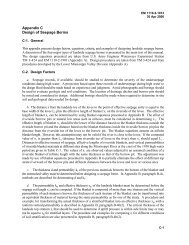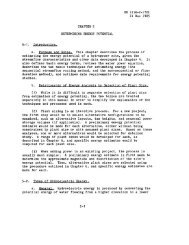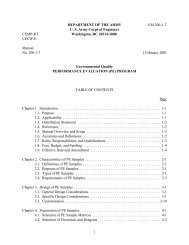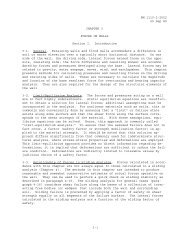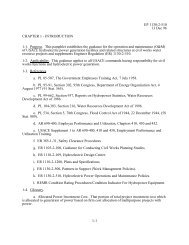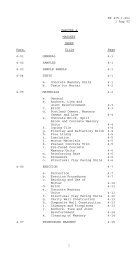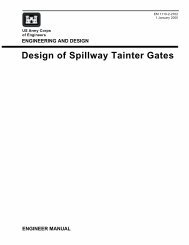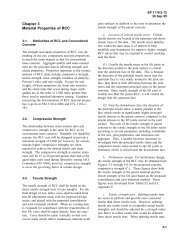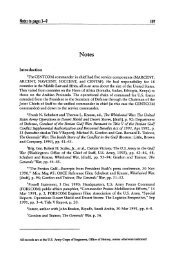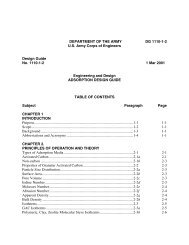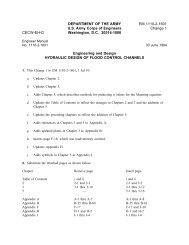Earthquake Design and Evaluation of Concrete Hydraulic Structures
Earthquake Design and Evaluation of Concrete Hydraulic Structures
Earthquake Design and Evaluation of Concrete Hydraulic Structures
You also want an ePaper? Increase the reach of your titles
YUMPU automatically turns print PDFs into web optimized ePapers that Google loves.
EM 1110-2-6053<br />
1 May 2007<br />
Performance under MDE loading conditions should be within the non-linear strain hardening<br />
range (Damage Control). The strain s<strong>of</strong>tening range provides reserve capacity against collapse<br />
<strong>and</strong> represents the concrete capacity to absorb additional energy dem<strong>and</strong>s from earthquake<br />
ground motions. Additional information on the tensile capacity <strong>of</strong> plain concrete structures can<br />
be found in Chapter 5.<br />
(b) The response <strong>of</strong> an arch dam to earthquake ground motion is shown in Figure 2-6. Arch<br />
dams are generally built as independent cantilever monoliths separated by vertical contraction<br />
joints. Since contraction joints can only transfer limited tensile stresses in the horizontal arch<br />
direction, the joints can be expected to open <strong>and</strong> close repeatedly as the dam vibrates in response<br />
to severe earthquake ground motion. The contraction joint opening releases tensile arch<br />
stresses but increases compressive stresses <strong>and</strong> vertical cantilever stresses by transferring<br />
forces to the cantilevers. The increased compressive stresses could lead to concrete crushing,<br />
especially due to impact <strong>of</strong> joint closing. The increased vertical cantilever stresses could exceed<br />
tensile strength <strong>of</strong> the lift lines (or horizontal joints); in which case tensile cracking is likely to<br />
occur along the horizontal lift lines. High tensile stresses also develop along the dam-foundation<br />
interface <strong>and</strong> could cause cracking along the dam-foundation contact or could be absorbed by<br />
minor displacements <strong>of</strong> the jointed foundation rock.<br />
Contraction Joint Opening<br />
Cracks<br />
Figure 2-6. Response <strong>of</strong> Arch Dams to Major <strong>Earthquake</strong>s<br />
(3) Response to stability controlled actions. Once cracking has propagated through the<br />
structure along potential failure planes, or along joints where the tensile strength can be substantially<br />
less than that <strong>of</strong> the parent concrete, the structural stability against sliding or rotation<br />
should be considered. Rotational failures <strong>of</strong> a massive concrete hydraulic structure are highly<br />
unlikely due to wedging action that limits the rotation. Note that rotational stability assessed<br />
based on a 2D analysis ignores additional resistance that might exist due to 3D effects. Even in<br />
a straight gravity dam, especially if built in a narrow valley, each monolith can draw resistance<br />
from adjacent blocks to remain stable. <strong>Evaluation</strong> <strong>of</strong> this mode <strong>of</strong> failure is discussed in following<br />
paragraphs <strong>of</strong> this Chapter <strong>and</strong> in Chapter 7. Sliding due to shear failure can occur, leading<br />
to unacceptable permanent displacements. The sliding displacements should be evaluated<br />
whenever the shear dem<strong>and</strong>s along potential failure planes exceed the sliding resistance<br />
(shear-friction capacity). An estimate <strong>of</strong> the permanent displacement can be made using the<br />
upper bound sliding displacement methods described in Chapters 4 <strong>and</strong> 7. Non-linear analysis<br />
methods are also available for determining the permanent displacement (Fronteddu et al., 1998;<br />
Chavez <strong>and</strong> Fenves, 1993).<br />
2-8




